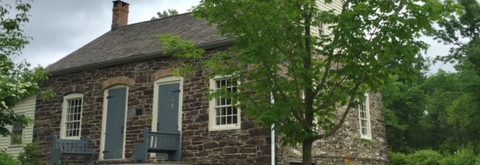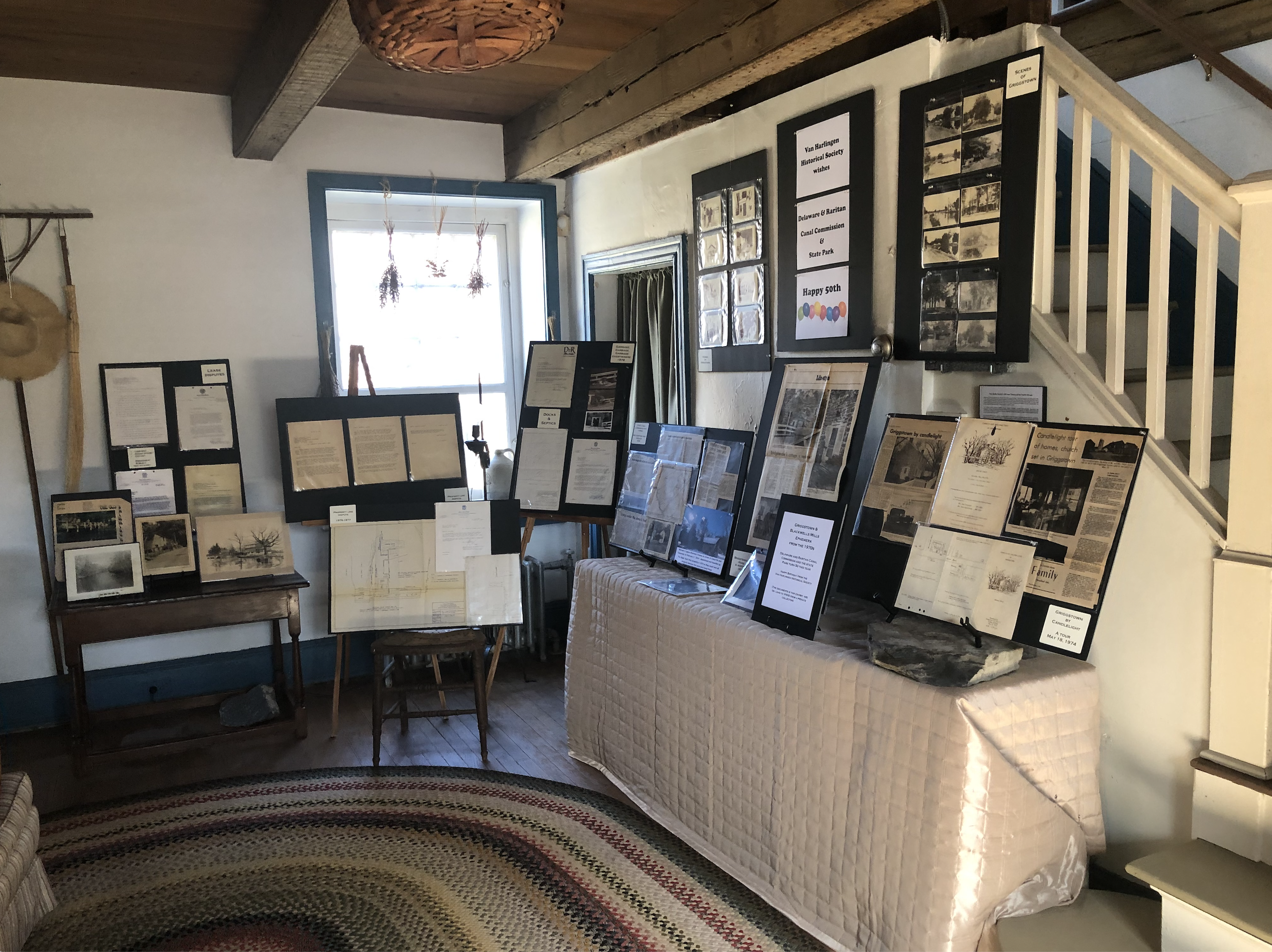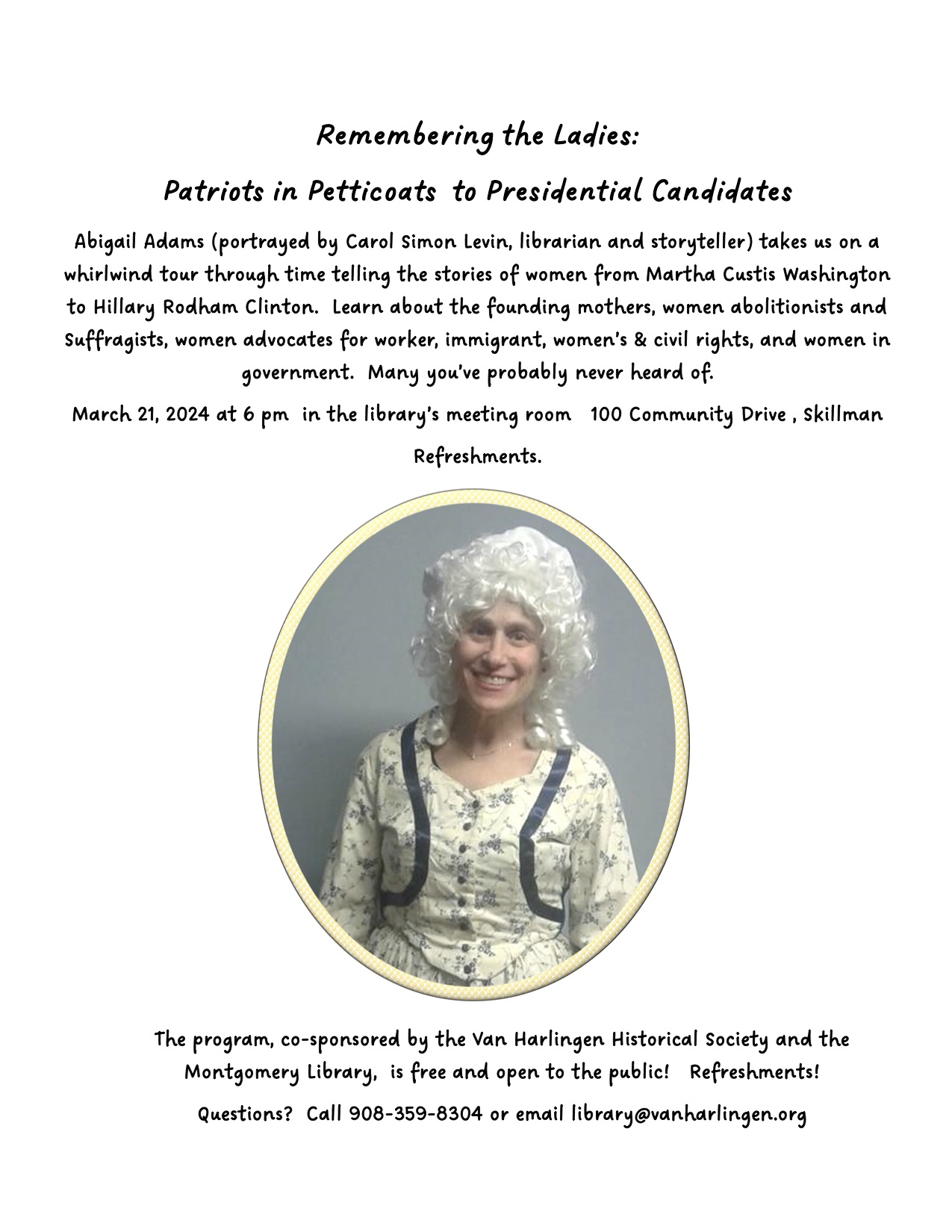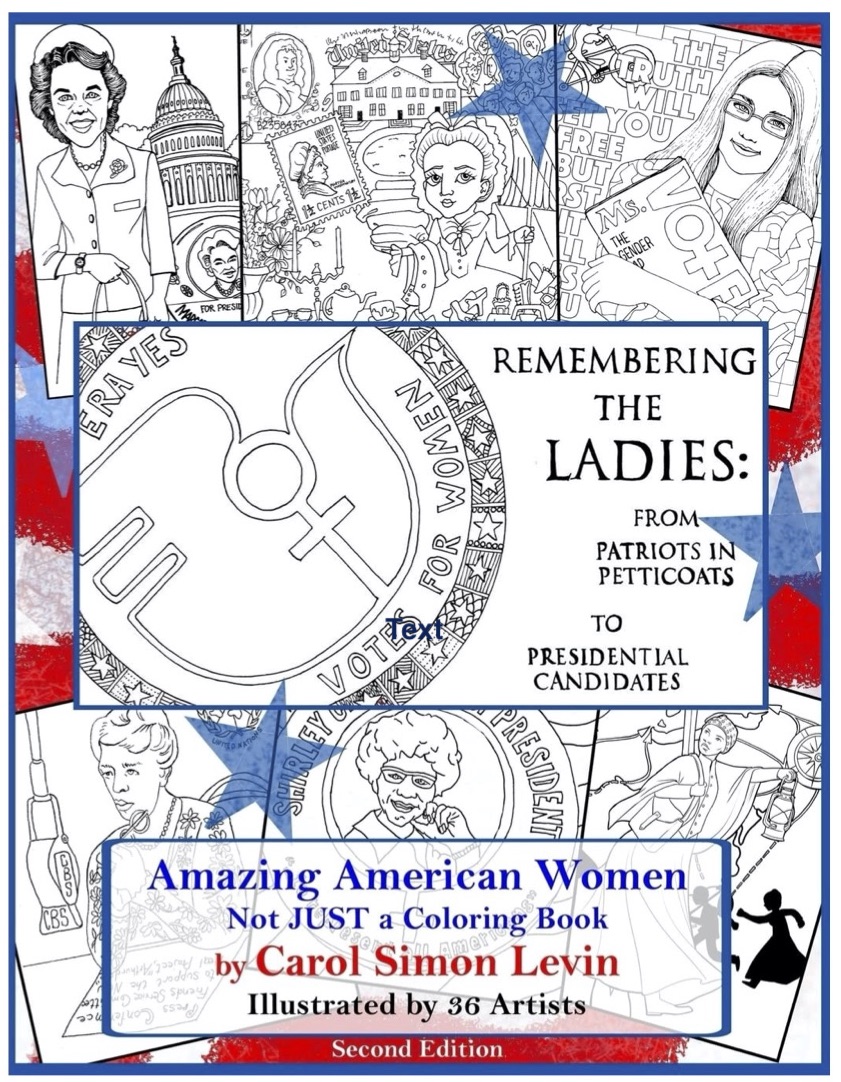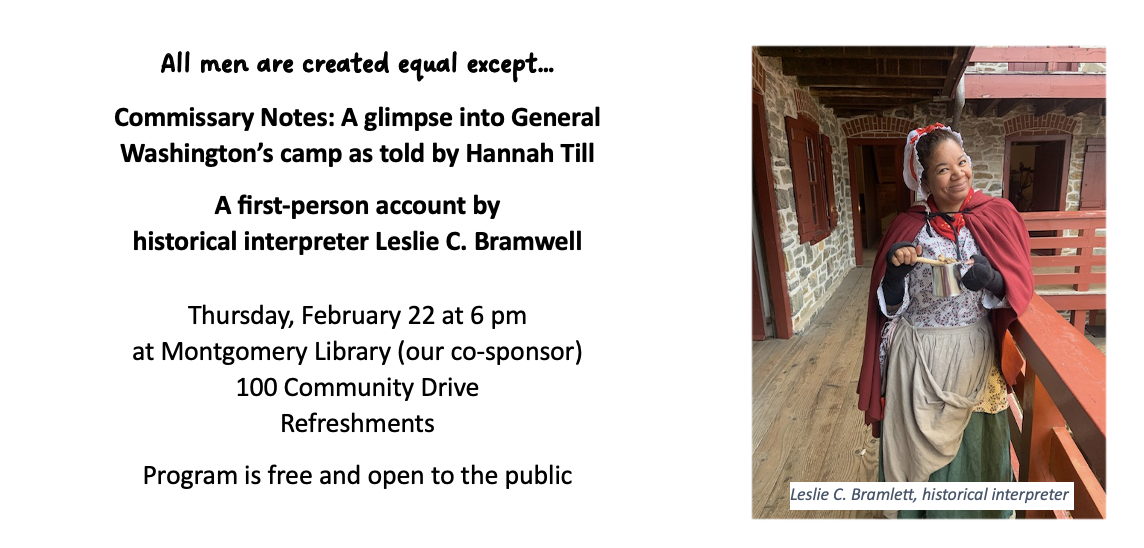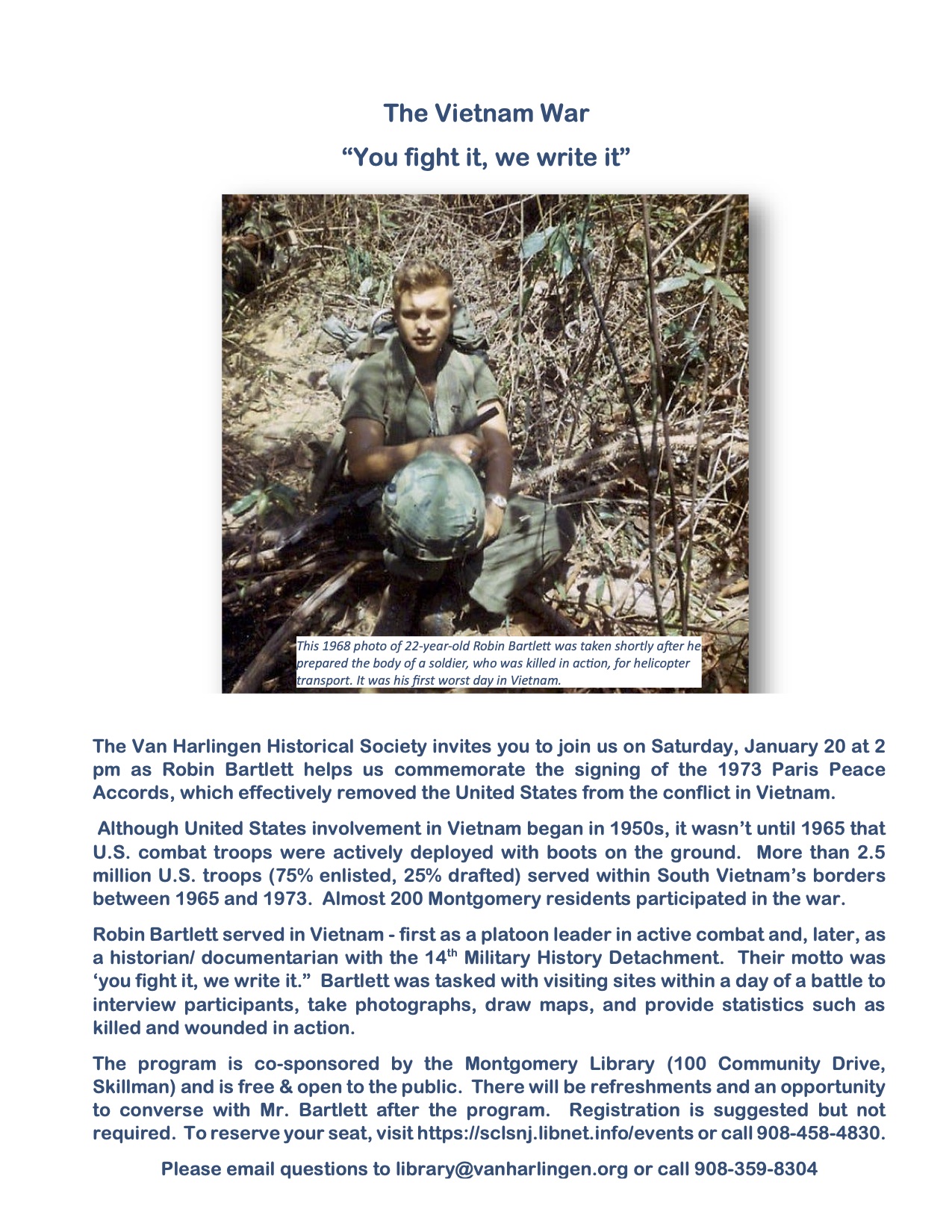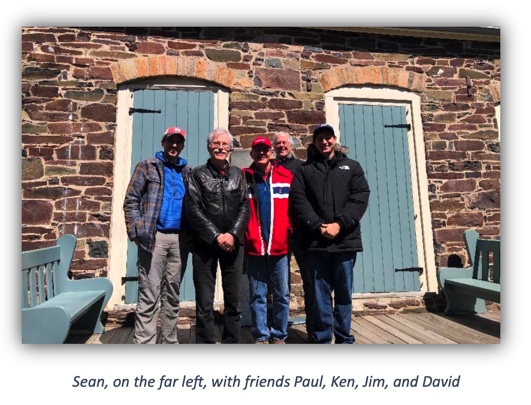Editor’s Note: Mark Lindquist spent his early years in the same house that our local historian, Jessie Havens, now lives. He visited her a short time after the death of his mother, and their visit was filled with stories of his time in Montgomery. Jessie encouraged Mark to write down all these great memories for all to enjoy. The following was written for the Van Harlingen Historical Society by Mark. His lengthy and remarkable detailed memoir is much too long to publish in just one issue of our newsletter, and we have been including excerpts in the Spring and Fall 2016 issues. But here for your enjoyment, is the complete manuscript. We’ve added a few images from our VHHS Image Collection.
Background
I lived with my parents, Captain Roy George Lindquist and Vivian Beatrice (Bergstrom) Lindquist, on Ludlow Avenue in Belle Mead, in the house that Jesse Havens has lived in since 1974, between 1954 and 1959, and again with just my mom between 1961 and 1966. After one year in Owings Mills, MD, just outside Baltimore, where my mother worked as a librarian at McDonough School, a prep school where I could attend for free, we returned to Montgomery Township and built a ranch home along the brook on Cherry Brook Drive, at the other end of Montgomery Township. I was part of the last sending district from Montgomery Township to Princeton High School, where I graduated in 1970. My mother lived on Cherry Brook Drive until 1989, when she moved to Wisconsin to be near my wife and me. Mom passed away in 2011, at 94, and always pined for her years in Belle Mead and Montgomery Township.
My family came to Belle Mead from Paris, France, where my father had been stationed on the staff for SHAPE (Strategic Headquarters Allied Powers Europe) from 1951 to 1954. General Dwight David Eisenhower had been his first commander there – a framed picture and signed letter from “Ike” welcoming my father to his staff hangs above a mantle in our family room in Ripon, WI. When Mamie Eisenhower purchased new champagne glasses, she gave her old ones to my parents, and I remember the etched patterns on the last one, before it, too, was broken at one of my parents’ famous parties on Ludlow Avenue.
I was born in Paris in 1952, at the American Hospital, and spent my first two years in an apartment in Neuilly-sur-Seine, in between the Bois de Bologne and the Seine River; the picturesque neighborhood underwent urban renewal in the 60s and lost all resemblance to the place my parents loved, but I visited it before the renewal when I was eight and met my parents’ landlords and some French friends, one who had been shell-shocked in WWI. My parents told me that my first words from the baby carriage were “du pain” (bread) as my mother pushed me past one of the fragrant Parisian bakeries.
From 1954 to 1956, my father was stationed at the Belle Mead Depot. He then spent a “hardship tour” as an advisor in Saigon, Vietnam in 1956-57 (his years in France had made him fluent in French, the second language of many colonized South Vietnamese). From 1957 to 1959, he commuted from Belle Mead to Hempstead, Long Island, where he taught in the ROTC program at Hofstra University. His supervisor there called him the most gifted teacher he had ever overseen.
Part of the Army Corps of Engineers, he had responsibility at the Belle Mead Depot for making sure the buildings were kept in good operating shape. Roy had been born in 1921 in Naperville, IL, and after serving in the merchant marine when the war started (German U=boats twice torpedoed and sank his ships off the South American Coast – he recalled living on hardtack in lifeboats before being rescued), he fought in the Pacific Theater from 1941 until 1945 with an engineering unit that secured beaches after landing troops had stormed islands. His unit was heavily wounded and decorated; among the various pins and medals he wore were two purple hearts, although, like most of his generation, he never talked about the War.
From 1947 to 1949, he served as the platoon leader of an African-American unit (troops were still segregated) in South Korea, where he met my mother, who had been born in tiny Hudson, SD (pop. 200+), in 1917, and was serving in the Red Cross. When she left Korea in 1948 to return to Hudson to help her sister, Myrtle, care for their dying mother, my father wrote to her from Korea two and sometimes three times every week, and Mom kept all those letters for me to read after she had passed. I read them by firelight at a campground near Hudson, where I buried my mom’s ashes in an urn with a map of the world etched in it, and I made sure she could look right through Paris up to Heaven.
My primary memory of the Depot in Belle Mead was of trailing my father around the strange golf course he had designed around the buildings. My father was an avid golfer, who had played for the state championship in Illinois at 16 (before dropping out of high school to ride the rails during the Depression) and would later compete for European Army championships when he was stationed in Kaiserslautern, Germany, from 1959-1961. I had a miniature set of golf clubs, a miniature golf bag, and a miniature golf cart that I could play with. I don’t remember anyone having motorized golf carts in the fifties.
My father was also an aspiring artist, and an accompanying early memory from these times was of him behind an easel in the front lawn on Ludlow Avenue painting a slightly abstract canvas of our red, cedar-shingled, split-level house (it looked exactly the same, albeit with an expanded kitchen, when I visited Jesse Havens four years ago). That picture hangs in my office at UW- Madison.
Families on Ludlow, Bedle, and Bellemont
Mike Miles, a single man who lived just down Bedle Street in a room in Ethel Herder’s home, built the house on Ludlow Avenue (now #33 but then without a #), along with the one just west (?) of it. I believe these two houses were among the first, if not the first, homes built “on spec” in Montgomery Township. Doyle and Shilke, who soon became reputable builders in their own right, and who built our second home on Cherry Brook Drive, got their start working for Mike Miles. Doyle eventually lived around the block from us on Bellemont Rd. I believe I remember playing with friends in the woods and fields where Bellemont would soon be laid out before the road was built (but I just checked for the spelling of the road, and saw a home for sale that was supposedly built in 1952 – I don’t think that is accurate, but Jesse will know).
What I consider my first memory is from the porch on Ludlow watching a carful of kids begin to move into the house built by Mike Miles right next to us (there is a photo of this event, so probably I just remember seeing the photo, but it’s still a very early memory). The Sherist family had at least six kids, and the second youngest of them, Louie, became my first friend. We played with matchbox toys (Jesse found one of them digging in the garden earlier this past year and sent it to me as a Christmas gift), sometimes “souping them up” with playdough wheel covers, dual exhaust pipes, and fins, in the familiar fifties sporting auto style. We sometimes scavenged wooden blocks from building sites in the neighborhood to build little cities in the dirt to drive the cars around.
We also gathered wild strawberries, raspberries and blackberries from the fields and woods near the two houses. Sometimes we sucked nectar from honeysuckle blossoms on vines creeping up wild cherry trees, and we even tried the sour and tiny cherries once or twice. Other times we sneaked concord grapes from a neighbor’s old grape arbor. We were often covered in calamine lotion, because we were always getting into poison ivy. Our mothers picked woodticks from our hair, and washed us with rags soaked in gasoline when we came in covered in tar from playing along the roadside.
Down the street toward the train station lived the Dix and Virginia (Ginny) Skillman family, who were probably my parents’ best friends in the early years. Around that time, Dix built his office (also red cedar-shingled – friends and I painted it one summer when we were in college) on Rt. 206, right next to the train station, and started a partnership called the Belle Mead Development Corporation, which was responsible for much of the transformation of Montgomery Township from a farming district in the early fifties to a commuter district of subdivisions by the mid- sixties. I think one of the Calpins (sic?) and others were involved. For a time, my father studied law in the night school at Temple University, I think to join Dix as a lawyer at some point, but Dad never finished law school.
The Skillman kids, Peter and Abby, were a bit older than I, so not really my friends, but I remember learning how to ride Abby’s bike on the Skillmans’ front lawn (a “girl’s” bike was easier to mount). I also remember Dix and Peter hooking up our first television in the pine- paneled family room in the back of the house. Peter was interested in electronics as a kid, and eventually became an engineer.
On the other side of the street from the Skillmans, but closer to Rt. 206, were the Cains, who were, I think, longtime friends of the Skillmans, and probably bridge partners of my parents. Mr. Cain was a house painter, but retired when I was quite young, if not earlier. They spent their summers in the Thousand Islands in the St. Lawrence Seaway, and eventually retired there.
Their son, Tom (?), who must have been fifteen to twenty years older than I was, earned a Ph.D. in Physical Education and taught at SUNY-Cortland for many years. I remember a night in the sixties when Tom, in one car, led my mother and me, in another, home from the Skillmans’ through flooded Canal Rd. along the Millstone Canal, where the Skillmans had moved to an elegant pre-Revolutionary War Home in Griggstown (my friends and I painted that home when we were in college, as well). Ed. Note: Black Horse Inn.
Across the street from us lived another Cain, Helen, and her developmentally delayed daughter, whose name I do not remember, although she sometimes babysat for me. Helen was an elementary school teacher in Raritan, I think. I do not think she was related to the Cains down the street, and I might be misremembering her name (Jesse will know). Helen had another daughter, and that daughter and her husband eventually built an extension to Helen’s house, which effectively made it a duplex. When I visited Jesse, I think the Cain daughter and husband were still living there.
Further down Ludlow, at the corner with Bellemont, lived the Marshall family, who had three boys in my age range and a daughter with downs syndrome, who died while the family lived on Ludlow, perhaps prompting them to move to Princeton around 1960. I forget the name of the oldest son, but Scott, a year older than I, and Todd, a year younger, were daily playmates. Todd sometimes slept over at our house. The father, Donald, I think, had a Ph.D. in engineering and worked at one of the corporate research centers around Princeton, maybe RCA? The oldest son was a talented cartoonist who went to Pratt Institute in New York City, after graduating from Princeton High School.
At the very end of Ludlow lived two single women, one of whom worked in NYC. I mention this only because I have vivid memories of her driving her black car at breakneck speed to and from the Train Station. My mother was terrified that she would run over one of the neighborhood kids, as we were always playing in the road. I believe Mom talked to the woman more than once about her fears, but nothing changed.
Helen Cain lived on the corner of Bedle and Ludlow, the Herders lived in the next house down Bedle, and the Shinkos family, whose only son Jeff, two years older than I, was one of my best friends growing up, lived in the next. Jeff’s father worked at various jobs in NYC, and for a time was the President of the Hill-Mont Little League, which Jeff and I both played in (I was an All- Star!). I kept up with Jeff into our thirties, but lost touch. Having graduated from Waynesburg College, in western PA, with a Math major, he was then living in Palatine, IL, and was a travelling salesman. As kids, Jeff and I spent many a summer night sleeping in a tent and listening to the Top 40 on a transistor radio, either in one of our backyards, or alongside the creek at the end of Bedle Street.
The Parrs lived in the next house, at one corner of Bedle and Bellemont. Art Parr was a local plumber, a friendly guy who was always smiling. His oldest daughter, Cynthia, married Jeff Shinkos in their early or mid-twenties (Cynthia was three years younger than Jeff), but the marriage did not last long. The Parrs and the Nelsons, who lived on Bellemont Rd, were in-laws. Debbie Nelson, Cynthia’s cousin, was one of my classmates at Montgomery Township Elementary School.
On the opposite corner of Bedle and Bellemont, in a house painted green, lived the Daniels. Bruce Daniels, three years older than I, had the most elaborate and marvelous Lionel Train setup, complete with landscaping, tunnels, hills, cities, trees, etc., in what seemed like half of his basement. In adulthood, he worked as a reporter for the Newark Star Ledger, I think (although unrelated, Jeff Shinkos had the Star Ledger paper route in our neighborhood, and I sometimes got to sub for him). I’m not sure what Bruce’s father did, but I remember a big bear of a guy, always with a fat cigar in his mouth.
Across the street from the Shinkos’s lived the Millers, Bob and Grace, who were among my mother’s best friends (when my mother and I returned to Belle Mead in 1961, we spent a week or two living with them before the renters moved out of the Ludlow house, and I always called them “Aunt” Grace and “Uncle” Bob). Bob was the head of the International YMCA in Germany, if not all of Europe, I don’t quite remember. Grace was one of Mom’s bridge partners, and a confidant when my parents’ marriage began to falter, after Dad’s year in Vietnam. When Grace died, Bob soon married his longtime secretary, much to my mother’s disapproval, but I believe Bob and Grace are buried side-by side in the cemetery in back of what used to be called the Belle Mead Inn. They were among the more aristocratic of Mom’s friends.
Other than the Nelsons, Daniels, and Marshalls, the only family I knew on Bellemont was the Lawrence family. Bruce Lawrence, a year older than I, was an on-again, off-again, friend, whose life, at least through high school, where he graduated a year late with my class, did not start off well. I hope things improved for Bruce. His older brother graduated from Ithaca College. Not sure what the father did.
I have talked about fathers’ jobs in this section because in the fifties and early sixties, my mother was the only mom among my friends’ families who worked. In the late fifties, Vivian was a real estate agent — the agency she worked for was in the same building as the Skillman Law firm. When we returned to Belle Mead in 1961, she was a high school English teacher and subsequently the Librarian from 1961-66 and 1967-1983 at Manville High School. Mom had a B.A, in English and American Studies, from St. Olaf College, in Northfield, MN, and taught in Okabena, MN from 1939-42, before moving to Sioux Falls, SD to teach pilots radio signaling at the Air Force Base, and then joining the Red Cross in Washington, D.C. at the end of the War. She earned an M.L.S at Rutgers University by taking classes evenings and summers in the early sixties. My parents’ marital difficulties and ultimate divorce necessitated Mom’s working, or my mother would never have worked – she was quite content as a fifties’, “Leave it to Beaver”, homemaker.
